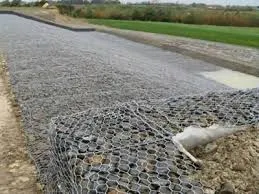
Oct . 11, 2024 09:03 Back to list
Installing a Barbed Wire Fence for Enhanced Security and Property Protection
The Practicalities and Purpose of Putting Up Barbed Wire Fences
Barbed wire fences have long been a staple in agricultural and property management. Typically made of twisted strands of wire with sharp barbs positioned at intervals, these barriers serve numerous purposes. From keeping livestock secure to demarcating property lines, the implementation of a barbed wire fence can significantly enhance the functionality and security of any given space. In this article, we will explore the various aspects surrounding the installation of barbed wire fences, including their benefits, the methods of installation, and important considerations to keep in mind.
Benefits of Barbed Wire Fences
One of the primary advantages of barbed wire is its cost-effectiveness. Compared to other fencing options, such as wooden or vinyl fences, barbed wire is considerably less expensive to purchase and install. This affordability makes it an attractive choice, especially for farmers and landowners who may need to enclose large areas of land.
Additionally, barbed wire fences are incredibly effective at keeping livestock and unwanted animals within or outside a designated area. The sharpness of the barbs acts as a deterrent, preventing animals from pushing through the fence. This characteristic is particularly beneficial in regions where livestock grazing is prevalent, reducing the risk of animals straying onto roads or neighboring properties.
Moreover, barbed wire fences require low maintenance. Once installed correctly, they can withstand various weather conditions and do not rot or warp as wooden fences do. This durability further solidifies their economic advantage, as landowners can save time and money on repairs and replacements.
Installation Process
Installing a barbed wire fence requires careful planning and execution. Here’s a step-by-step guide to facilitate the process
1. Planning Before any physical work begins, it’s essential to plan the fence’s layout. Mark the corners where the fence posts will be placed and calculate the necessary materials based on the perimeter that needs to be fenced.
2. Choosing Materials Select durable barbed wire along with corrosion-resistant posts (wooden, metal, or fiberglass) that are strong enough to withstand tension. Ground staples may also be required to hold the wire in place.
3. Installation of Corner and End Posts Begin by digging holes for the corner and end posts. Ensure they are set deeply and securely to handle the tension of the fencing wire.
putting up barbed wire fence

4. Straining the Wire Once the posts are set, unroll the barbed wire and stretch it between the posts, ensuring it remains taut. This is crucial for maintaining the integrity of the fence.
5. Attaching the Wire Use wire clips or staples to attach the barbed wire to the posts. Remember to leave some slack to allow for expansion and contraction due to temperature changes.
6. Installing Intermediate Posts Place intermediate posts at regular intervals, as these will support the wire while preventing sagging.
7. Final Checks After installation, inspect the entire fence for any loose sections or sharp edges that could pose a safety risk.
Considerations Before Installation
While barbed wire fences serve many purposes, it is essential to consider local regulations and community guidelines before installation. In some areas, there may be restrictions on the height and type of fencing materials used, especially near roads or in residential neighborhoods.
Furthermore, it is vital to communicate with neighbors regarding the installation of a barbed wire fence. Transparency can reduce potential disputes related to property lines and ensure that everyone is aware of the changes taking place.
Lastly, consider the type of livestock or wildlife in the area. Some species may be more prone to injury from barbed wire, prompting consideration of alternative fencing methods that might offer similar levels of security without the risk of harm.
Conclusion
In conclusion, putting up a barbed wire fence is a practical choice that offers numerous benefits for landowners and farmers alike. Its cost-effectiveness, durability, and ability to secure property make it a favored option for fencing needs. However, successful installation hinges on careful planning and consideration of local regulations, ensuring that the fence serves its intended purpose without causing unnecessary issues. With the right approach, a barbed wire fence can provide years of reliable service, safeguarding both property and livestock efficiently.
-
Why a Chain Link Fence is the Right Choice
NewsJul.09,2025
-
Upgrade Your Fencing with High-Quality Coated Chicken Wire
NewsJul.09,2025
-
The Power of Fence Post Spikes
NewsJul.09,2025
-
The Best Pet Enclosures for Every Need
NewsJul.09,2025
-
Secure Your Property with Premium Barbed Wire Solutions
NewsJul.09,2025
-
Enhance Your Construction Projects with Quality Gabion Boxes
NewsJul.09,2025
Products categories











